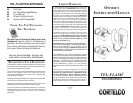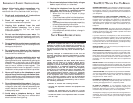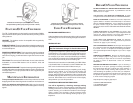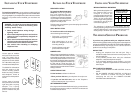
IMPORTANT SAFETY INSTRUCTIONS
Always follow basic safety precautions when
using your telephone equipment to
reduce the risk of fire, electrical shock, and injury.
1. Read and understand all instructions
in the Owner’s Instruction Manual.
2. Read all warnings and follow all
instructions marked on the product.
3. Unplug this product from the wall
outlet before cleaning. Use a damp
cloth for cleaning. Do not use liquid
or aerosol cleaners.
4. Do not use the telephone near water. For
example, do not use near a bathtub, wash bowl,
kitchen sink, laundry tub, swimming pool, or in a
wet basement.
5. Do not place this product on an unstable cart
or stand. The product may fall causing serious
damage to the product.
6. Do not place any objects on the telephone
line cord. Do not locate the telephone where the
line cord will be walked on.
7. Do not block or cover ventilation slots and
openings in the bottom of the telephone. The
openings should never be blocked by placing the
telephone on a bed, sofa, rug, or other similar
surfaces. This telephone should never be placed
near or over a radiator or heat register. This
telephone should never be placed in a built-in
installation unless proper ventilation is provided.
8. Never spill liquid on the telephone or push
objects of any kind through ventilation slots.
Liquid or objects may touch dangerous voltage
points or short out parts that could result in a risk
of fire or electrical shock.
9. Do not disassemble this product. Opening or
removing covers may expose you to dangerous
voltages or other risks. Incorrect reassembly can
cause electrical shock when the product is
subsequently used.
10. Avoid using a telephone during a local
thunderstorm. There may be a remote risk of
electrical shock from lightning.
11. Do not use a telephone in the vicinity of a gas
leak to report the leak, or otherwise.
12. Unplug the telephone from the wall outlet
and refer servicing to qualified service
personnel under the following conditions:
• When the line cord is frayed or plugs
damaged.
• If liquid has been spilled into the telephone.
• If the telephone has been exposed to rain or
water.
• If the telephone does not operate properly by
following the operating instructions.
• If the telephone has been dropped or the
housing damaged.
• If the telephone exhibits distinct change in
performance.
SAVE T HESE INSTRUCTIONS
15-101-613
This device complies with Part 15 of the FCC Rules.
Operation is subject to the following two conditions: (1)
this device may not cause harmful interference, and (2)
this device must accept any interference received, in-
cluding interference that may cause undesired opera-
tion.
Warning: Changes or modifications to this unit not
expressly approved by the party responsible for compli-
ance could void the user’s authority to operate the
equipment.
NOTE: This equipment has been tested and found to
comply with the limits for a CLASS B digital device,
pursuant to Part 15 of the FCC Rules. These limits are
designed to provide reasonable protection against harm-
ful interference in a residential installation. This equip-
ment generates, uses, and can radiate radio frequency
energy and, if not installed and used in accordance with
the instructions, may cause harmful interference to
radio communications. However, there is no guarantee
that interference will not occur in a particular installation.
If this equipment does cause harmful interference to
radio or television reception, which can be determined
by turning the equipment off and on, the user is encour-
aged to try to correct the interference by one or more of
the following measures:
- Reorient or relocate the receiving antenna.
- Increase the separation between the equipment and
receiver.
- Connect the equipment into an outlet on a circuit
different from that to which the receiver is connected.
- Consult the dealer or an experienced radio TV techni-
cian for help.
THE FCC WANTS YOU TO KNOW
DESIGN COMPLIANCE Your telephone is designed to comply
with FCC Rules and Regulations, Part 68. It can be connected to
the telephone network as FCC-registered terminal equipment.
The registration number is printed on the label on the bottom of
your telephone.
NOTIFICATION TO THE TELEPHONE COMPANY As a
customer of the local telephone company, you must, if they ask,
tell them before connecting your telephone to the telephone
company lines. The telephone company may need the FCC
registration number and the ringer equivalence of the telephone.
This information is printed on a label on the bottom of your
telephone.
RINGER EQUIVALENCE The ringer equivalence indicates the
amount of power that your telephone draws from the telephone
company line during ringing. The number is printed on the label
on the bottom of your telephone.
If you have more than one telephone (or other terminal device)
connected to the telephone company line, you should total the
ringer equivalence numbers (REN’s), and be sure that the total
is not more than five. Your telephones may not ring if the total is
more than five. Also, in some rural locations, your telephone may
not ring if the REN total is more than three.
RESTRICTIONS You must not connect your telephone to coin-
operated lines or party lines.
INTERFERENCE POTENTIAL Your telephone has a push-button
dial that generates radio frequency energy. If not properly used,
it may interfere with radio and television reception. If the tele-
phone does cause interference with reception, move the radio
or television to another electrical circuit or another location. If
necessary, you may need to seek advice from an experienced
technician.
INSTALLATION This model telephone must be connected to the
telephone company lines through a modular jack. The required
USOC for the modular jack is RJ11C for desk mounting and RJ11W
for wall mounting. The USOC number is printed on the label on the
bottom of your telephone.
TYPE OF DIALING Your telephone has a push-button TONE dial.
You must have TONE service from your telephone company to
use your telephone for dialing. Note that you will usually be
charged extra for TONE service.
HEARING-AID COMPATIBILITY The handset on your telephone
will work with magnetically-coupled hearing aids. You can use
a hearing aid equipped with a T (Telephone) switch.
IN CASE OF TROUBLE If your telephone should cause
problems on the telephone line, the telephone company can
temporarily disconnect your service. The telephone company
must then notify and allow you to correct the problem.
The telephone company may from time to time change its lines or
equipment. They must notify you if planned changes will affect
your telephone service, to allow you to take steps to prevent
interruptions.






